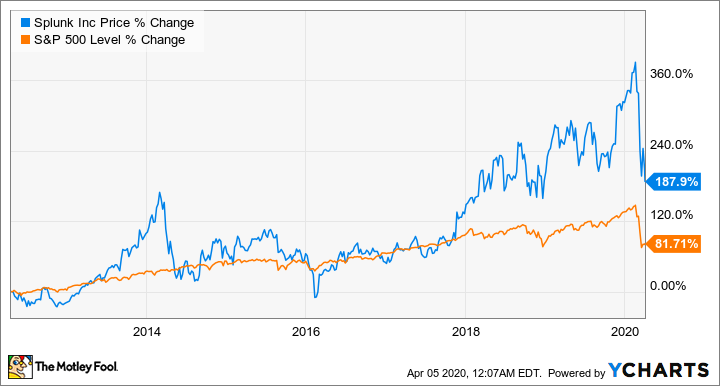Splunk (SPLK) made its debut in the equity markets on April 19, 2012. Splunk priced over 15 million shares at $17 each, raising about $264 million in its IPO.
Shares gained over 109% on their first day of trading after closing at $35.48. The stock went on to generate massive returns over the years and is trading at $102.14 as of this writing. The stock had previously touched an all-time high of $176.31.
So how much would an investor have if he or she invested $1,000 in the IPO? An investor could have purchased 58 shares for $986, and that investment would now be worth $5,924, yielding six times the original investment. Even buying in after that first day surge, shareholders would still enjoy a nearly 200% gain, easily outperforming the broad market as you can see below.
Data by YCharts.
A business overview
Splunk is one of the more dynamic and innovative players in big data and provides tools enabling enterprises to make better decisions with real-time visibility. Splunk is fast making its presence felt in the data analytics space.
The company's platform helps clients simplify and modernize information technology for critical functions to increase uptime, which further provides them with a competitive advantage. Companies can monitor or troubleshoot across cloud, virtual, and physical infrastructures.
Enterprises cannot afford to let IT systems fail, as such roadblocks can impact the top line. By leveraging Splunk's solutions, clients can now monitor and measure performance and response time for mission-critical applications.
In case you have workloads running on clouds, Splunk has an analytics solution to get visibility into cloud costs and help forecast demand. The company can help customers monitor a variety of applications, gain valuable insights, and improve several aspects of the application lifecycle.
What makes Splunk a solid long-term bet?
In fiscal 2020 (ended Jan. 31, 2020), revenue rose 31% to $2.36 billion, while adjusted earnings were up 41% to $1.88 per share. Annual recurring revenue rose 54% to $1.68 billion, and the company's shift to a subscription-based model is almost complete.
In 2019, Splunk announced it would move to a software-as-a-service (SaaS) model. Such a move would enable the company to generate a stable stream of recurring subscription sales, thus helping it offset cyclicality and economic downturns.

Image Source: Getty Images.
While Splunk's top line in fiscal 2021 is likely to be impacted by COVID-19, its long-term prospects remain strong given the company's expanding addressable market and increasing customer base. The company estimated its total addressable market at $62 billion, and this has doubled since its IPO.
In fiscal 2020, Splunk managed to expand its customer list with additions like McLaren Racing, one of the largest players in the motor-racing space. Splunk's data-to-everything platform will help McLaren improve customer engagement and capture data across the organization.
Discovery, the media and television company, will leverage Splunk Cloud to gain insignt into the customer-streaming experience. The streaming analytics data provided by Splunk should help Discovery improve the viewership experience, which will increase the company's customer-retention rate.
Several existing customers, such as the Washington Post, are expanding their use of Splunk's services, and this is driving overall revenue growth. In the fourth quarter, Splunk managed to record 221 customer orders with an average contract value (ACV) of over $1 million, up from 179 in the prior-year period. It also landed 35 deals with an ACV of greater than $10 million, up from 24 last year.
Why Splunk stock will be volatile in the short-term?
Splunk shares will be range-bound in the next few months as investors try to analyze the impact of the COVID-19 on the company's top line. Furthermore, its shift to a SaaS-based model will also result in near-term cash flow disruptions.
The company ended perpetual licensing with most of its customers and shifted them to renewable contracts. In a perpetual licensing business, revenue is realized immediately when a contract is signed, while in a SaaS business, it is realized over time.
Management expects revenue to grow just 6% year over year in the fiscal 2021 first quarter and by 10% in fiscal 2021 overall. This will put pressure on the company's profit margins and cash flow metrics.
Splunk is asking investors to focus on its annual recurring revenue (ARR) growth, which is expected to fall in the mid-40% range in fiscal 2021. The company is optimistic about sustaining ARR growth of around 40% through fiscal 2023 and reaffirmed its operating cash flow target of $1 billion for that year.
The verdict
Splunk should continue to enlarge its customer base as it will benefit from the exponential growth in data. Its sales guidance for 2021 is tricky due to an increase in cloud mix, but the renewal of previously booked contracts will boost revenue growth in fiscal 2022 and beyond.
In terms of profitability, Splunk expects a negative operating margin of 25% in the first quarter and breakeven for fiscal 2021. However, it aims to increase the operating margin to 20% by fiscal 2023.
Splunk has a forward price-to-sales valuation of 6.2, which is reasonable considering its estimated growth rates. High-growth peers such as Okta, The Trade Desk, Shopify, and Twilio are all trading at higher forward price-to-sales multiples with Shopify hitting 20 times.
Long-term investors can look at the 40% pullback in Splunk stock as a buying opportunity. The company's growing market, expanding margins, and rising cash flow make it a solid bet for this decade.






